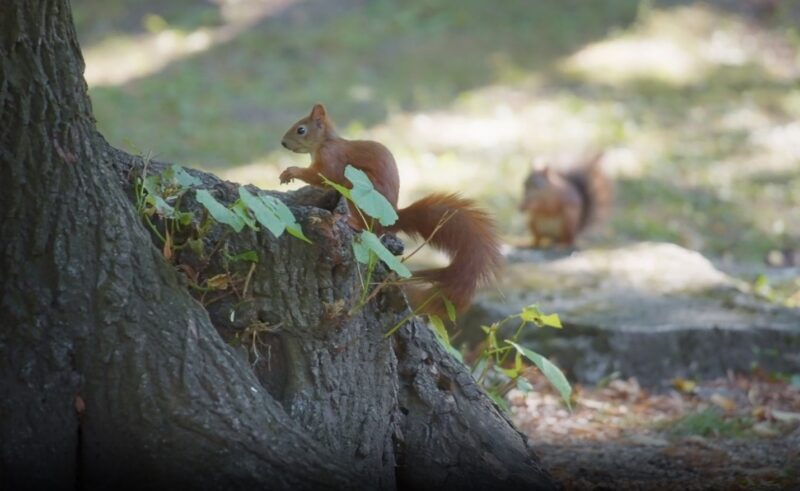Watching squirrels chase each other can be an entertaining sight, with their acrobatic antics and rapid pursuits through the trees. These chases, often mistaken for playful behavior, serve a variety of important functions in squirrel society.
Squirrels are known for their complex set of behaviors, communicating with one another and establishing hierarchies within their communities.
One of the primary reasons squirrels chase each other is territorial defense. Like many animals, squirrels are protective of their space, especially when it comes to food resources or nesting areas.
Adult male squirrels, in particular, are known to pursue others at high speeds, attempting to drive off intruders and maintain their dominance, which is an essential aspect of their survival strategies.
These pursuits are also part of their mating rituals, as males may chase females in a display of vigor and suitability as a mate.
Key Takeaways
Social Interactions
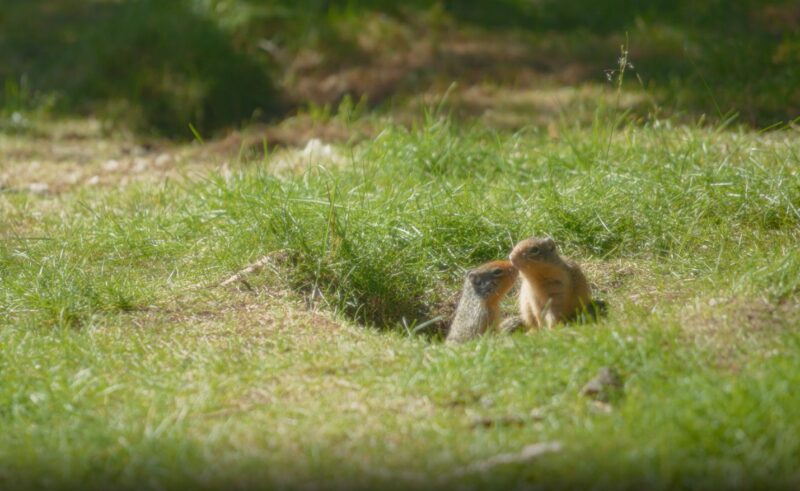
Squirrels are generally solitary animals but do interact during mating season or when defending their territory. They communicate through a series of vocalizations, tail signals, and sometimes through scent marking.
Territoriality
Squirrels are territorial creatures. An adult may chase another squirrel away from its claimed area, especially if it feels its resources such as food or shelter are threatened.
Play
Young squirrels engage in chasing as a form of play. This activity helps them develop their physical abilities and learn skills necessary for survival.
Mating Pursuits
Chasing is also a component of the mating ritual for squirrels. Males may chase a female in an effort to prove their suitability as a mate.
Feeding Habits
Squirrels primarily eat nuts, seeds, fruits, and sometimes insects. They are known for their habit of food hoarding, which helps them survive during scarce periods.
Adaptability
These animals have adapted to various environments and can thrive in urban areas by learning to find food in bird feeders and garbage bins.
Squirrels are fascinating creatures to observe, and their playful chases are just one aspect of their complex behaviors.
Mating Rituals
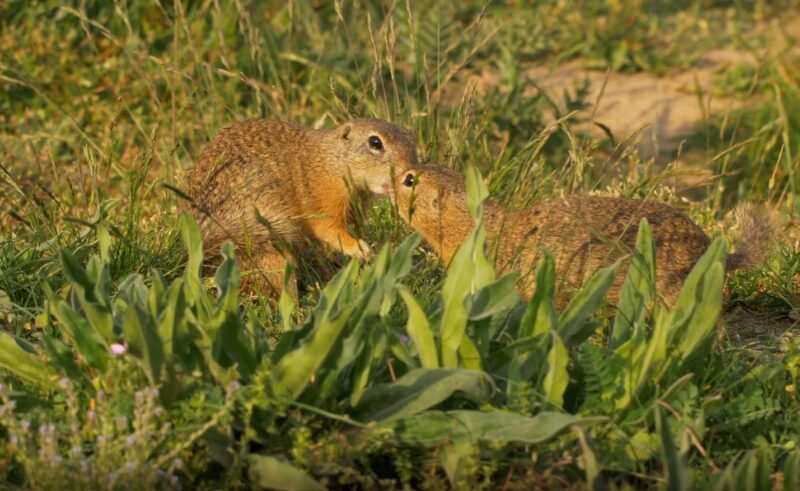
When observing squirrels and their social interactions, particularly during mating season, one can witness a complex display of behaviors that are essential for their reproductive success.
Courtship Pursuits
Male squirrels participate in vigorous chases to win the attention of a female. These chases involve a dominant male slowly pursuing a female, signaling his interest.
If the female is receptive, she will allow the chase to continue, culminating in mating.
Territorial Displays
In addition to the chase, male squirrels assert dominance through territorial displays to fend off competitors.
Spiraling up and down trees, males may chase away intruders to protect their potential for mating. These pursuits serve as a display of vigor and strength, indicating a suitable mate.
Survival Strategies
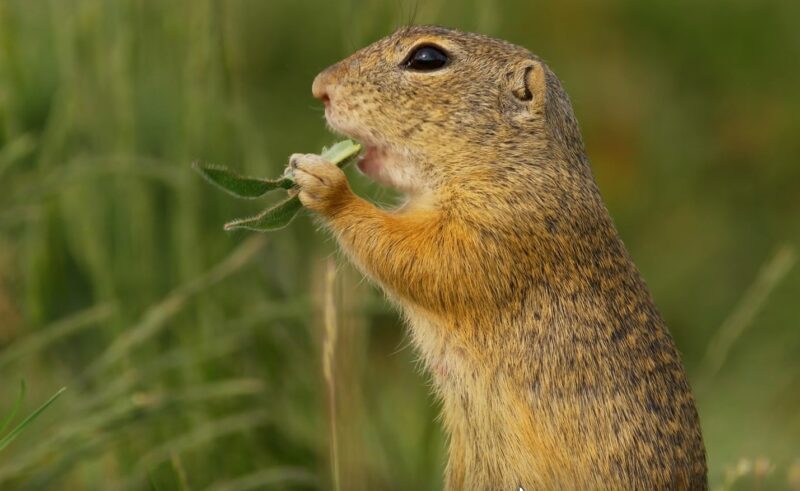
In the dynamic world of squirrels, survival hinges on their swift movements and keen senses. These nimble creatures utilize chasing both to navigate threats and to secure resources.
Predator Evasion
When under threat, squirrels often engage in chasing behaviors as a tactic to evade predators.
Through erratic running and agile leaps, they confuse and exhaust their pursuers. This high-speed game of tag can give squirrels the vital seconds they need to escape to safety.
Food Scouting
Chasing also plays a critical role in food scouting.
Squirrels may chase one another to establish dominance over food sources or to assess the availability of food in different areas, particularly when there’s competition.
By monitoring each other’s actions, they learn about and adapt to the changing locations of food, which is essential for survival during lean times.
Communication Signals
Squirrels employ a range of communication signals during their interactions.
One of the primary reasons squirrels chase one another is to communicate different messages, which could be related to territory, mating, or social hierarchy.
Visual Signals
Chasing itself is a dynamic visual display. A squirrel in pursuit is delivering a clear message to the one being chased that they might be trespassing or may need to show submissiveness.
Auditory Signals
Often accompanied with chasing are vocal communications.
Squirrels use a variety of calls and chirps when in pursuit, especially during mating chases.
These sounds can be seen as both an announcement of presence and a means to attract attention.
Olfactory Signals
Scent marking is also a form of communication among squirrels.
Females may emit scents to indicate fertility, and males may use scents to mark territory.
Tail Movements
The movements of a squirrel’s tail can indicate their mood or intentions. A twitching tail during a chase can signify excitement or agitation.
| Signal Type | Purpose | Example |
|---|---|---|
| Visual | Territorial display | Pursuit, spiraling trees |
| Auditory | Attraction or warning | Calls, chirps |
| Olfactory | Marking territory, mating | Scent marking |
| Tail | Emotion, intention | Twitching, flicking |
Seasonal Patterns
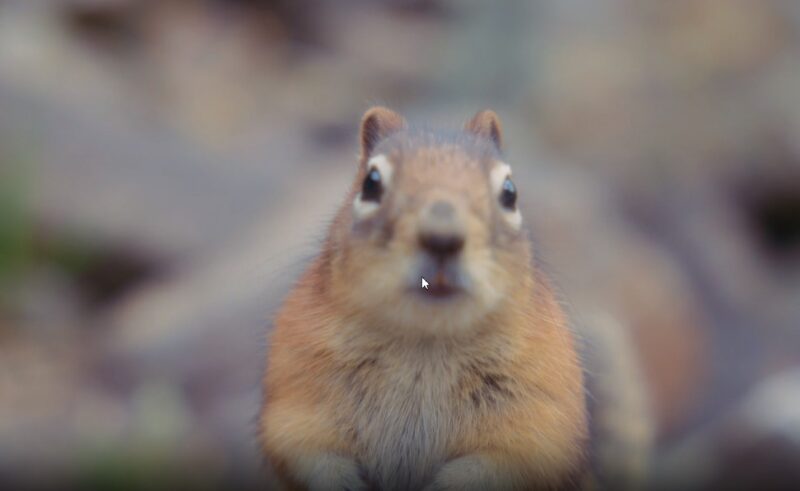
In observing the behavior of squirrels, one may notice that their chasing activities often align with various seasons, showcasing interesting patterns tied to their life cycles.
Spring
This season is marked by an increase in chasing, primarily as a part of the mating process.
Male squirrels engage in pursuit of females, signaling a display of vigor and suitability as a mate.
Mating Chases
- These can be quite vigorous, with multiple males often chasing a single female as part of their mating ritual.
Summer
The warming temperatures and abundant food sources lead to juveniles being more active.
Young squirrels may chase each other in a playful manner, which serves as practice for developing their agility and strength, necessary for survival in the wild.
Playful Activity
- This includes mock fights and chasing games among the young.
Fall
As the season of harvesting and storing begins, the squirrel’s focus can shift to protecting their territories and food caches.
One might observe more chasing as adult squirrels work to ward off potential thieves.
Territorial Disputes
- Chasing during this time often involves tail flicking and vocalizations as warnings.
Winter
With colder weather and less food availability, one could expect to see less chasing. However, squirrels still venture out to guard their territories and access stored food, possibly leading to occasional chases.
Frequently Asked Questions
Are squirrels chasing each other engaging in play?
Young squirrels are known to chase each other in a manner that appears purely playful. Such activity helps in their development and social skills as they interact with siblings and other juveniles.
Can squirrels exhibit aggressive behavior towards one another?
Chasing in adult squirrels can escalate to aggressive behavior, usually when it’s a matter of protecting a territory.
Territorial disputes may result in one squirrel nipping at another until the chased party retreats.
Do squirrels participate in chases as part of their mating rituals?
Mating season sees an increase in chasing, as male squirrels pursue potential mates.
This type of chasing is part of the natural mating process and is distinctive from playful or territorial chases.
Is it common for squirrels to twitch their tails in social interactions?
Tail twitching is a common form of communication among squirrels. It may signify excitement, frustration, or serve as a warning to others. During chases, tail movements are used as signals and can indicate a variety of moods or intentions.
How do squirrels communicate with each other during pursuits?
Squirrels use a combination of vocalizations and bodily movements to communicate during chases.
High-pitched squeaks may serve to deter other squirrels, while body language, like the aforementioned tail twitches, relays a range of messages and cues.
What does it signify when squirrels engage in a fight?
Fights among squirrels, while not as common as chase behavior, usually signify serious disputes over resources or territory.
Such behaviors are more pronounced during mating season or when food is scarce, indicating high stakes in the competition among squirrels.
Conclusion
Squirrel chases are not mere acts of play but essential behaviors with profound implications for their survival and social structure.
These pursuits reflect the complexities of squirrel society, from establishing territorial dominance and facilitating mating rituals to enhancing survival skills among the young.
By understanding these chases, we gain insights into the adaptive strategies and intricate communication methods squirrels employ, highlighting their intelligence and the critical role these behaviors play in their natural ecosystem.
Related Posts:
- What Do Squirrels Eat? - Nutritional Facts
- What Sounds Do Squirrels Make? - From Bark to Whistle
- Why Do Foxes Scream at Night? Vocal Enigmas of the Night
- Why Do Moose Have Antlers? - From Decoration to Weaponry
- Why Do Moths Eat Your Clothes? - Wardrobe Woes
- Why Do Frogs Scream? Are these or Help or Something More?


